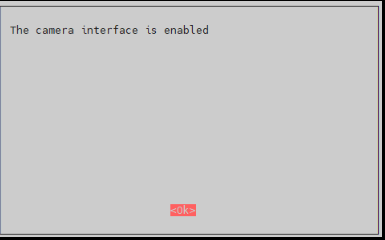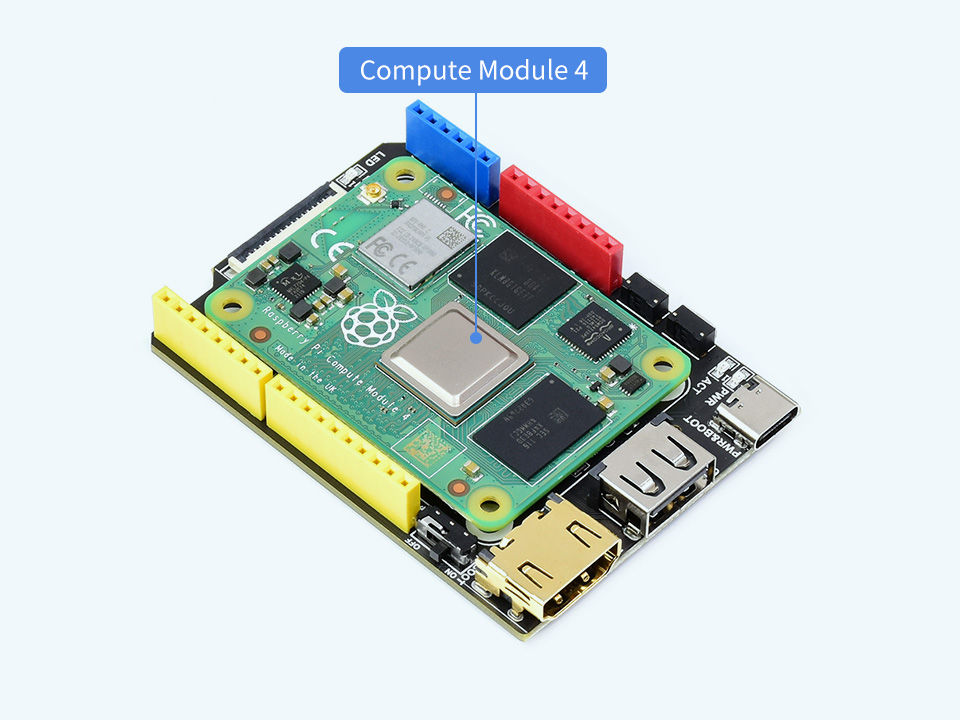Difference between revisions of "CM4-Duino"
(Created page with "<div class="tabber"> <div class="tabbertab" title="Introduction"> {{infobox item| |name=CM4-Duino |img=<div class="tabber"><div class="tabbertab" title="CM4-Duino">File:CM4-...") |
|||
| Line 15: | Line 15: | ||
| − | {{CM4 | + | {{CM4 Duino Spec}} |
</div> | </div> | ||
Revision as of 10:55, 15 March 2022
| ||
Overview
I am a CM4 duino basic expansion board, an expansion board that can be used with Raspberry Pi Compute Module 4, and supports 5V DC power supply with Typc-C interface. Onboard HDMI interface, one CSI interface and one USB interface, standard arduino interface, etc...
Precautions for use
1: Do not plug and unplug any device except USB and HDMI when powered on.
2: Type C interface can be used as a power supply or as a USB interface to burn images (need to use BOOT switch to switch).
3: In order to ensure the normal power supply of CM4, please do not connect other devices when using the Type C interface to burn the image.
4: When CM4 is in normal use, it needs to provide a 5V 2A power supply for CM4. Otherwise, there may be problems such as automatic shutdown, frequency reduction, and so on.
5: USB2.0 is closed by default, if you want to open it, you need to add dtoverlay=dwc2,dr_mode=host in config.txt.
Product Size
What's on board
| Label | Name | Description |
| 1 | Power supply/burning interface | 5V/2A power supply, can also be used as an eMMC burning interface |
| 2 | USB 2.0 interface | USB 2.0 interface, support various USB devices to be inserted |
| 3 | HDMI port | HDMI port, supports 4K 30fps output |
| 4 | BOOT switch button | ON: Compute Module 4 boots to USB Type-C port OFF: Compute Module 4 boots to eMMC or Micro SD card |
| 5 | CM4 Connector | Applies to all versions of Compute Module 4 |
| 6 | CAM Interface | MIPI CSI Camera Interface |
| 7 | User LED | LED blinks and sparkles |
| 8 | ADC Chip | 8-bit ADC, I2C interface, 8-channel ADC chip ADS7830 |
| 9 | User Button | Button Module |
| 10 | GPIO | Arduino interface GPIO |
| 11 | Function Switch | For details, please refer to the function pin description |
| 12 | M.2 Interface | A module that supports NVME SSD solid state or other PCIE channels |
| 13 | Micro SD Card Slot | For inserting a Micro SD card with the system to start the Compute Module 4 Lite |
Hardware Connection
Precautions
Do not plug or unplug any device while it is powered on.
Writing Image
- Write Image for Compute Module Boards eMMC version
- Wrote Image for Compute Module Boards Lite version
RTC FAN
Fan voltage switching
As shown in the figure, the FAN voltage is switched according to the position of the resistor, and the default is 12V.

- Note: Please connect the fan before turning on the power of the base board and then complete the test. Please do not connect the fan after the base board is powered on, because the fan control chip has been powered on, otherwise the chip will be burned!
- Note: Before connecting, please confirm whether the rated voltage of the fan is consistent with the voltage actually connected to the fan.
Please note that DSI and CSI are prohibited when using RTC.
I2C-10 is used by default
RTC (PCF85063a) on i2c-10, address is 0x51 (7-bit address)
FAN ( EMC2301 ) on i2c-10, address is 0x2f (7-bit address)
If you need to add it to your program instead of the kernel, you can refer to the C and Python demo reference click here
RTC
sudo nano /boot/config.txt #Add the following lines at the end dtparam=i2c_vc=on dtoverlay=i2c-rtc,pcf85063a,i2c_csi_dsi #Add # in front of dtparam=audio=on #dtparam=audio=on #Save and exit, restart sudo reboot
How to use Hwclock
Synchronize system clock to hardware clock.
sudo hwclock -w
Synchronize hardware clock to system clock.
sudo hwclock -s #The network or the NTP needs to be closed, otherwise it will be changed back.
Set the hardware clock time:
sudo hwclock --set --date="9/8/2021 16:45:05"
View hardware clock.
sudo hwclock -r
Display version information.
sudo hwclock --verbose
Fan
When powered on, the fan will spin for 1 second, then stop for 2 seconds, and then spin again, this is a normal phenomenon
There is no official configuration method for the fan currently, there is a third-party configuration method: https://github.com/neg2led/cm4io-fan
This method is published by a third party, and we are not responsible for any problems!
sudo apt-get install dkms
mkdir -p ~/src
cd ~/src
git clone https://github.com/neg2led/cm4io-fan.git
cd cm4io-fan
sudo chmod 777 install.sh
sudo ./install.sh
#If an error message appears: Your kernel headers for kernel 5.XX.XX-v7l+ cannot be found at
#After rebooting the device, you can execute it
#The following is the description of config.txt
#############################
Name: cm4io-fan
Info: Raspberry Pi Compute Module 4 IO Board fan controller
Load: dtoverlay=cm4io-fan,<param>[=<val>]
Params: minrpm RPM target for the fan when the SoC is below
mintemp (default 3500)
maxrpm RPM target for the fan when the SoC is above
maxtemp (default 5500)
midtemp Temperature (in millicelcius) at which the fan
begins to speed up (default 50000)
midtemp_hyst Temperature delta (in millicelcius) below mintemp
at which the fan will drop to minrpm (default 2000)
maxtemp Temperature (in millicelcius) at which the fan
will be held at maxrpm (default 70000)
maxtemp_hyst Temperature delta (in millicelcius) below maxtemp
at which the fan begins to slow down (default 2000)
#############################
Or directly refer to the following:
dtoverlay=cm4io-fan,minrpm=500,maxrpm=5000,midtemp=45000,midtemp_hyst=2000,maxtemp=50000,maxtemp_hyst=2000
The fan will start to accelerate when the temperature is higher than 45 degrees Celsius, and will up to the highest speed when higher than 50 degrees Celsius.
CSI DSI
Configuration file
CSI and DSI are disabled by default. When using the camera and DSI, it will occupy three I2C devices: I2C-10, I2C-11, and I2C-0.
- Open a terminal and run the following commands:
sudo apt-get install p7zip-full -y wget https://files.waveshare.com/upload/7/75/CM4_dt_blob_Source.zip 7z x CM4_dt_blob.7z -O./CM4_dt_blob sudo chmod 777 -R CM4_dt_blob cd CM4_dt_blob/ # If using two cameras and DSI1 execute sudo dtc -I dts -O dtb -o /boot/dt-blob.bin dt-blob-disp1-double_cam.dts # In the use of any DSI, HDMI1 no image output, even if you do not connect the DSI screen as long as the corresponding file compiled, that HDMI1 no output # If you need to restore, delete the corresponding dt-blob.bin can be: sudo rm -rf /boot/dt-blob.bin #Execution is complete, power off and restart CM4
New Version (Bullseye)
Camera Config
-
Execute the following commands to edit "/boot/config.txt" file.
sudo nano /boot/config.txt
- Block or remove the automatic camera detection statement:
-
Add the driver of the camera you are using, here I take IMX219 as an example and connect it to CAM0, and attach the adapter.
Model CAM0 Set Sentence CAM1 Set Sentence OV9281 dtoverlay=ov9281,cam0 dtoverlay=ov9281,cam1 IMX290/IMX327 dtoverlay=imx290,clock-frequency=37125000,cam0 dtoverlay=imx290,clock-frequency=37125000,cam1 IMX378 dtoverlay=imx378,cam0 dtoverlay=imx378,cam1 IMX219 dtoverlay=imx219,cam0 dtoverlay=imx219,cam1 IMX477 dtoverlay=imx477,cam0 dtoverlay=imx477,cam1 IMX708 dtoverlay=imx708,cam0 dtoverlay=imx708,cam1 - If you are using the official Raspberry Pi camera and only one camera is connected, there is no need to set the config file. If it is not an official camera, set the "dtoverlay" statement without the "cam" suffix.
- CM4-NANO - only CAM0 is used, so you only need to add "dtoverlay=imx219,cam0".
5. Ctrl+x to exit the editor.
6. Reboot the Raspberry Pi.
sudo reboot
Camera Test
- Enter the camera detection command, you can see that the camera is detected by now.
libcamera-hello --list-cameras
- Display the camera screen on the desktop.
- Taking photos.
libcamera-jpeg -o test.jpg
- Record a video of 10s.
libcamera-vid -t 10000 -o test.h264
Other Commands
libcamera-hello -t
Check whether the camera is detected:
libcamera-hello --list-cameras
Open the corresponding cameras:
libcamera-hello --camera 1 libcamera-hello --camera 0
Take a photo:
libcamera-jpeg -o test.jpg #Add --camera to specify a camera
Old Version (Buster)
Camera Config
-
1. Execute the following command to enter the Raspberry Pi configuration.
- Test the recording function:
- Where -t 10000 means recording for 10 seconds, users can adjust according to their own needs.
- Please refer to CSI.
sudo raspi-config
2. Choose Interfacing Options and enter.

3. Choose Camera:

4. Choose to enable the camera interface.

5. The system prompts as follows:

6. Back to the main interface, select Finish.

7. Reboot the system.

Camera Test
raspistill -o image.jpg
raspivid -o video.h264 -t 10000
Openwrt
Overview
Openwrt has high customization and scalable performance. Openwrt is becoming more and more popular at present. Compared with commonly used wireless routers, openwrt's modifiable firmware allows us to customize router functions according to our own needs, such as single-arm routing, automatic Define routing policies, qos, intranet penetration, etc. Note: We do not provide any technical support for Openwrt system if there has any problem during use, only provide he following tutorials and images, and no other technical support other than hardware is provided.
Configure
The openwrt image configured above supports CM4 onboard wifi and the driver of RTL8153. CM4 can be turned into a smart router,
The following will tell you how to install Openwrt on the Raspberry Pi to realize the function of a wireless router, so that the devices in the LAN can access the Internet through the wireless router, and realize the intelligent management of the LAN. The overall network topology is as follows

After booting correctly, log in to the system:
The computer is connected to the ETH0 interface, and then directly ssh remote login or web page login
The configured system default IP is: 192.168.14.1
The default IP of the system without configuration is: 192.168.1.1
Account: root without password


If you think the network port is not enough, you can buy it USB 3.2 Gen1 TO Gigabit ETH RTL8153 expansion network port, if there is one ETH/USB HUB AT RTL8152 can also expand the 100M Ethernet port and support it.
Document
- Schematic
- Raspberry Pi Compute Module 4 IO Board Brief
- Raspberry Pi Compute Module 4 IO Board Datasheet
- CSI Camera Reference
- DSI Display Reference
Demo codes
3D Drawing
Software









